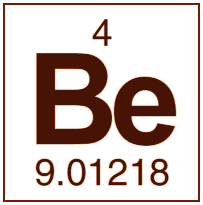 Yesterday’s post about the illicit attempt to obtain Swedish anthrax cultures referred also to the theft of a ton of beryllium in Sweden. The article also noted that beryllium is “radioactive”, and this latter assertion provoked some discussion in the comments.
Yesterday’s post about the illicit attempt to obtain Swedish anthrax cultures referred also to the theft of a ton of beryllium in Sweden. The article also noted that beryllium is “radioactive”, and this latter assertion provoked some discussion in the comments.First was Chuck, who said:
Beryllium isn’t radioactive but it does have health effects:
Beryllium causes lung and skin disease in two to 10 percent of exposed workers. Occupational exposure most often occurs in mining, extraction, and in the processing of alloy metals containing beryllium. The adverse health effects of beryllium exposure are caused by the body’s immune system reacting with the metal, resulting in an allergic-type response...
It is commercially available and is used in optics, x-ray equipment, nozzles, springs, and so on. It’s low atomic mass makes it useful for slowing down neutrons but that is hardly all it is used for. Remember, reporters hardly ever know squat about anything and can’t be bothered to do research, so treat the information in news reports with skepticism.
Then a4g responded:
Chuck,
I defer to anyone who actually knows what forms of beryllium are commercially available (and referred to in the referenced story), but I do know that there are quite a few isotopes of Be that are radioactive, most being very short lived, but 10Be having a half-life of 1,520,000 years.
Who knows, that might actually be long enough for the 12th Imam to finally show up.
He also pointed us to a very useful website, WebElements, which has a wealth of information about beryllium.
Finally there was Conservative Mutant, who works in biomedical research and has some expertise on the topic:
For these purposes, beryllium is distinctly not radioactive. Be-10 is formed by cosmic rays; there’s no way anyone would accumulate a ton of it. (BTW, the original Swedish article also says “beryllium”.) A major beryllium theft in 1993 (the beryllium turned out to be contaminated with a small quantity of HEU, although the thieves were apparently not aware of this) seems to have been connected with the Russian Mafia, probably for shipment to North Korea. (Beryllium is an excellent neutron reflector.)
Another source (William Potter, “Potter/Ewe11 Notes from Kurchatov/Semipalatinsk Conference and Excursions.”) says that “In 1995, 450 tons of beryllium was diverted and exported from the Ulba Metallurgy Plant in Ust-Kamenogorsk, Kazakhstan. Fifty tons of that material was sent to the port of Goteborg in Sweden, where it remains to this day.”
Ulba is the second-largest producer of beryllium in the world; presumably they’re also the source of the beryllium in the incident described by Jylands Post, which occurred in December 1995, while the beryllium was in transit from Russia to the U.S. via Stockholm.
Newsbeat1 sent us a link to an English-language article in The Local, which confirmed the essential facts as translated from the Jyllands-Post article. It did not however, refer to the theft of the beryllium.
Fortunately, Gates of Vienna has a resident chemical expert, namely the future Baron Bodissey, who just finished his junior year as a chemistry major at a respected Virginia institution of higher learning. He confirmed what Chuck and the Mutant were saying: the accumulation of any significant quantities of radioactive beryllium is highly unlikely. The atomic weight of beryllium is 9.012182, which means that only a very small portion of any quantity of beryllium would be radioactive, since the non-radioactive isotope of beryllium is 9Be. In that small portion of radioactive beryllium would be six isotopes, only one of which, 10Be, has a significant half-life (1.5 million years).
I think it’s safe to say that the newspaper reporter got his facts muddled. When he said that “a ton of beryllium was stolen… Beryllium is a radioactive material,” he should have said, “A ton of beryllium was stolen, a tiny portion of which may have been radioactive.” Typical MSM reportage — play fast and loose with the facts, with an emphasis on scare-mongering.
As Dymphna has recently pointed out, that’s where the blogosphere runs rings around the traditional media. Spurious “facts” are quickly outed and corrected by the distributed intelligence of our readers. Nice work, guys!
However, it does look like someone in Jordan tried to mail-order some Swedish anthrax. So far, that particular alarming fact still remains.

4 comments:
Thanks for the clarification.
It did seem a bit hard to believe, didn't it?
There's no doubt that beryllium is not radioactive. As for the isotopes, you can probably make radioisotopes out of anything - gold (Au-195 has a half-life of about half a year). Given enough of anything - a ton of gold, for instance, there'll be a few radioactive atoms. We shouldn't fault the reporter for not checking his facts. Fact-checking so so-o-o-o 1980s.
It is tricky to work with, though. You have to have in place a lot of strict safety measures, and workers have to be trained. It makes a terrific alloy.
Well, I would say whether the Beryllium is radioactive or not is the least part of the story... But you're right the reporter got "radioactive" and "toxic" mixed up, when he learned that it was used to increase the yield of nuclear weapons -- the critical mass of a plutonium sphere is significantly reduced if the plutonium is surrounded by a beryllium shell.
Beryllium forms alloys with more elements than any other element.
Biochemically it can displace many critical metals.
Hence it is considered as toxic as mercury and other forms of heavy metal posioning -- even though it's amoung the lightest elements.
It's sooo nasty that it is rarely used outside of the nuclear art.
Post a Comment